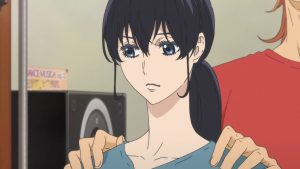 It’s been referred to on-screen enough times now that I think I’m going to credit the whole neck thing as an intentional move by Ballroom e Youkoso – the whole “dancer’s body” idea. I know I said I wasn’t going to be mentioning it again, but it’s worth nothing one more time because honestly, it was really the last major niggle (and intentional or not, I still think its a poor choice) I had with this series. It isn’t perfect by any means, but Welcome to the Ballroom – like its star – has clearly found its stride. With the last couple of episodes I’m really starting to appreciate just what all the fuss was about.
It’s been referred to on-screen enough times now that I think I’m going to credit the whole neck thing as an intentional move by Ballroom e Youkoso – the whole “dancer’s body” idea. I know I said I wasn’t going to be mentioning it again, but it’s worth nothing one more time because honestly, it was really the last major niggle (and intentional or not, I still think its a poor choice) I had with this series. It isn’t perfect by any means, but Welcome to the Ballroom – like its star – has clearly found its stride. With the last couple of episodes I’m really starting to appreciate just what all the fuss was about.
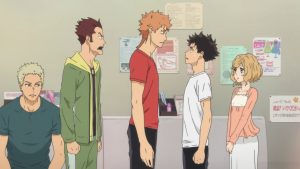 Like most good sports shounen, Ballroom e Youkoso has to have two major components in order to succeed. It has to give us a compelling coming-of-age story about its protagonist, and it has to present the sport it depicts in an engaging and exciting way. And I’m sold on both fronts. Tatara is a very easy kid to root for – I don’t think the importance of having a young seiyuu in Tsuchiya Shinba who really sounds like a kid can be overstated here, though it’s a well-written character to start with. And as with karuta or volleyball or kabuki, you reach a point where you’re either going to find all the minutiae about a topic like dance which (I’m just being honest here) most of the audience knows jack squat about interesting, or you’re not. I do – your mileage may vary on that score, but I think it’s possible to enjoy the series either way (though perhaps not quite as much).
Like most good sports shounen, Ballroom e Youkoso has to have two major components in order to succeed. It has to give us a compelling coming-of-age story about its protagonist, and it has to present the sport it depicts in an engaging and exciting way. And I’m sold on both fronts. Tatara is a very easy kid to root for – I don’t think the importance of having a young seiyuu in Tsuchiya Shinba who really sounds like a kid can be overstated here, though it’s a well-written character to start with. And as with karuta or volleyball or kabuki, you reach a point where you’re either going to find all the minutiae about a topic like dance which (I’m just being honest here) most of the audience knows jack squat about interesting, or you’re not. I do – your mileage may vary on that score, but I think it’s possible to enjoy the series either way (though perhaps not quite as much).
 As I gaze out over the relationship chart that’s formed here, my mind can’t but wander back to a quote from (in my opinion) the best sports shounen ever – “This is getting complicated”. On one level, pairing off Tatara and Mako-chan seems so logical it hurts – as Sengoku says, they’re the “short kids”. Gaju may be a douchebag but he’s not wrong in pointing out that partnering with Mako was holding him back – they’re physically mismatched. And of course, by extension it’s just as logical that Gaju and Shizuku are a much better pairing. But it’s not just that there seemed to be a red string of fate tying Tatara and Shizuku – there’s also that promise between (almost) men for he and Kiyoharu. A promise which, if we’re honest, he’s currently breaking. “What happens to the one that’s left behind?”
As I gaze out over the relationship chart that’s formed here, my mind can’t but wander back to a quote from (in my opinion) the best sports shounen ever – “This is getting complicated”. On one level, pairing off Tatara and Mako-chan seems so logical it hurts – as Sengoku says, they’re the “short kids”. Gaju may be a douchebag but he’s not wrong in pointing out that partnering with Mako was holding him back – they’re physically mismatched. And of course, by extension it’s just as logical that Gaju and Shizuku are a much better pairing. But it’s not just that there seemed to be a red string of fate tying Tatara and Shizuku – there’s also that promise between (almost) men for he and Kiyoharu. A promise which, if we’re honest, he’s currently breaking. “What happens to the one that’s left behind?”
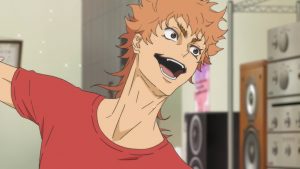 For now, though, the impending Tenpei Cup – and the challenge thrown down between Tatara and Gaju – means that that shounen battle mode takes priority over the relationship tangle. Mako has forced Sengoku’s hand and he now basically has no choice but to give Tatara real instruction, and this is where we get into the real nuts and bolts of dancing (and the audience’s interest level is tested). As here Sengoku is in his element – he knows this shit backwards and forwards (including the insider tricks) and even he can’t deny that Tatara-kun is a genius at quickly assimilating and reproducing what he sees.
For now, though, the impending Tenpei Cup – and the challenge thrown down between Tatara and Gaju – means that that shounen battle mode takes priority over the relationship tangle. Mako has forced Sengoku’s hand and he now basically has no choice but to give Tatara real instruction, and this is where we get into the real nuts and bolts of dancing (and the audience’s interest level is tested). As here Sengoku is in his element – he knows this shit backwards and forwards (including the insider tricks) and even he can’t deny that Tatara-kun is a genius at quickly assimilating and reproducing what he sees.
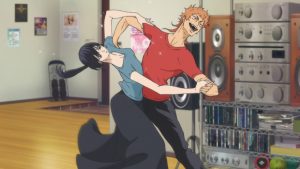 There’s so much to teach though, because Tatara knows so little – he’s not a lifer at dance like the other characters in this story. Even something as seemingly simple as avoiding collisions on the floor is complicated – I suppose on some level I knew a “Line of Direction” existed on a dance floor, but I never thought about it. And there’s also the matter of how to impress a judge – in this case the dance enthusiast Tenpei who (immodestly) sponsors the unofficial competition named for him. He loves flashy routines, and the quickstep is the key phase of the competition. Sengoku choreographs a routine for the kids that’s designed for one purpose – to impress Tenpei-san.
There’s so much to teach though, because Tatara knows so little – he’s not a lifer at dance like the other characters in this story. Even something as seemingly simple as avoiding collisions on the floor is complicated – I suppose on some level I knew a “Line of Direction” existed on a dance floor, but I never thought about it. And there’s also the matter of how to impress a judge – in this case the dance enthusiast Tenpei who (immodestly) sponsors the unofficial competition named for him. He loves flashy routines, and the quickstep is the key phase of the competition. Sengoku choreographs a routine for the kids that’s designed for one purpose – to impress Tenpei-san.
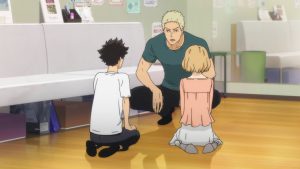 The dynamic of all this is very interesting. Tatara’s stakes for the throwdown are that Gaju must take back Mako-chan as a partner if he loses – but again, there are obvious issues with that. There’s also the fact that Gaju is revealed to be in love with Shizuku – since they were 9 years old, in fact. And Hyodo is out there convalescing too, of course. The issue of who should be partnering with who (on the floor and off) is very much at the heart of Ballroom e Youkoso, and I don’t think it’s been remotely settled yet (which is an unpredictable element I really like).
The dynamic of all this is very interesting. Tatara’s stakes for the throwdown are that Gaju must take back Mako-chan as a partner if he loses – but again, there are obvious issues with that. There’s also the fact that Gaju is revealed to be in love with Shizuku – since they were 9 years old, in fact. And Hyodo is out there convalescing too, of course. The issue of who should be partnering with who (on the floor and off) is very much at the heart of Ballroom e Youkoso, and I don’t think it’s been remotely settled yet (which is an unpredictable element I really like).
 Ultimately, though, I think (as usual with sports shounen) it’s the hero’s journey which will make or break this series. The phone conversation between Mako and Tatara that crowns the episode is a crucial one, I think – especially when she tells him “think of yourself more”. This is a common trait in shounen protagonists, but the revelation that Tatara’s parents are divorced (as opposed to his mother being dead, which would be far more of a trope) is an interesting added layer. Ultimately what we have here is a shy boy who’s uncomfortable being the center of attention but, on some level – as most of us do – really wants to be noticed. He’s slipped into the background for his whole life, been “left behind” by his mother. But now, through ballroom dance, he’s finally being paid attention to – and the fact that he loves that is to me a wonderful thing. Why shouldn’t he? If any sport is all about being a spectacle, calling attention to yourself, it’s competitive dance – and as such, it was the perfect tonic for malaise in Tatara’s soul.
Ultimately, though, I think (as usual with sports shounen) it’s the hero’s journey which will make or break this series. The phone conversation between Mako and Tatara that crowns the episode is a crucial one, I think – especially when she tells him “think of yourself more”. This is a common trait in shounen protagonists, but the revelation that Tatara’s parents are divorced (as opposed to his mother being dead, which would be far more of a trope) is an interesting added layer. Ultimately what we have here is a shy boy who’s uncomfortable being the center of attention but, on some level – as most of us do – really wants to be noticed. He’s slipped into the background for his whole life, been “left behind” by his mother. But now, through ballroom dance, he’s finally being paid attention to – and the fact that he loves that is to me a wonderful thing. Why shouldn’t he? If any sport is all about being a spectacle, calling attention to yourself, it’s competitive dance – and as such, it was the perfect tonic for malaise in Tatara’s soul.


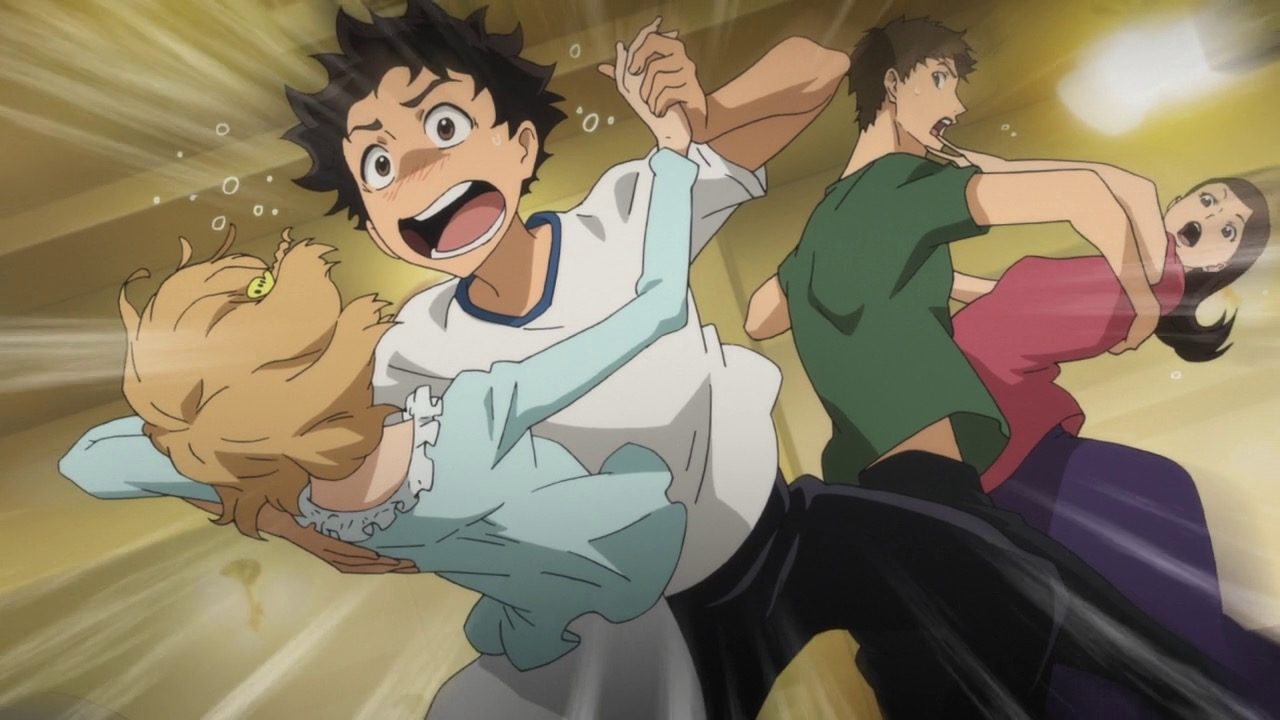
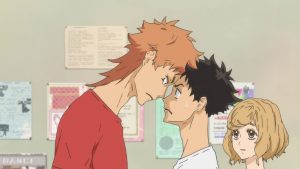




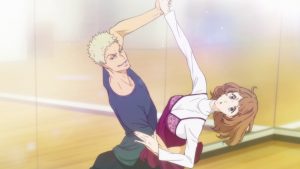


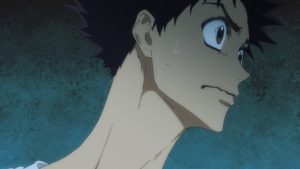
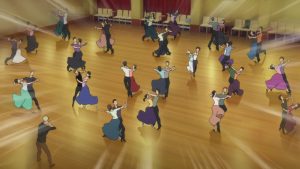
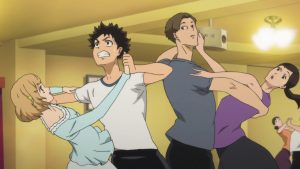
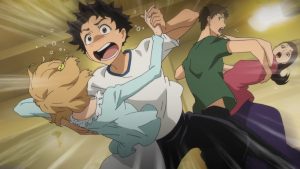
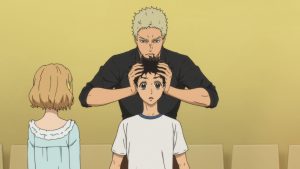
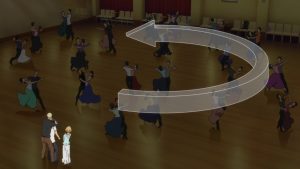
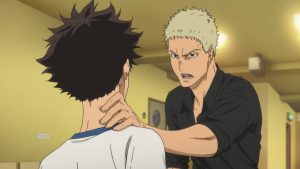
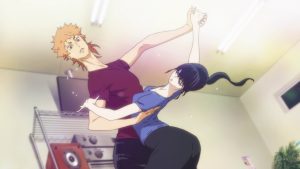
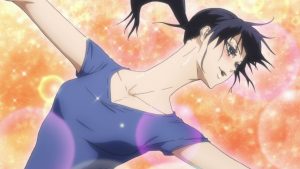


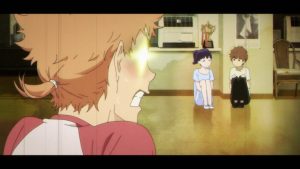
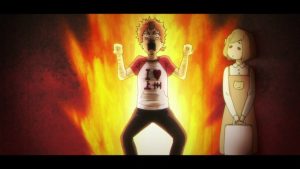

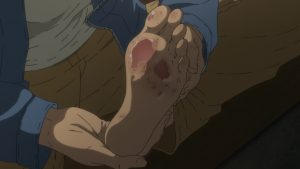



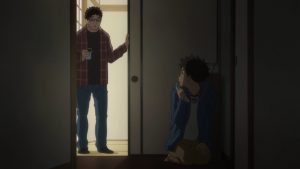

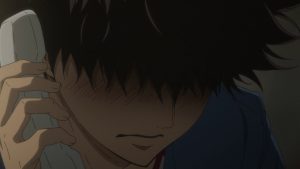
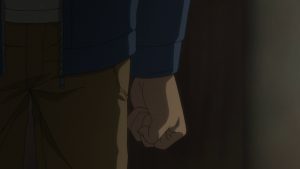

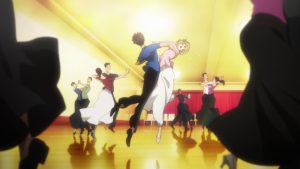

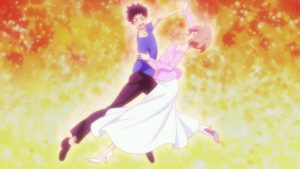

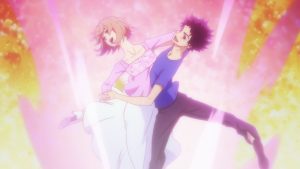
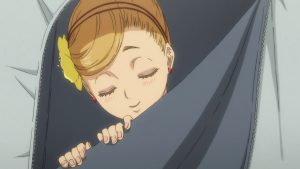
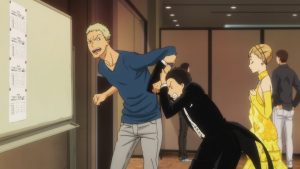
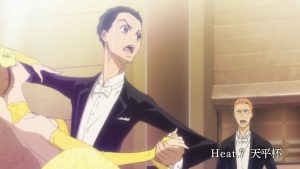


Molly
August 13, 2017 at 3:32 pmLovely review, Enzo. Glad to see that Sengoku finally be a useful instructor.